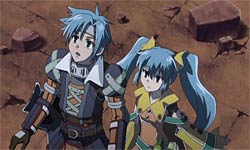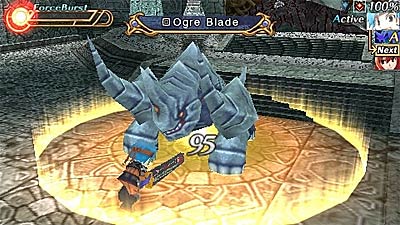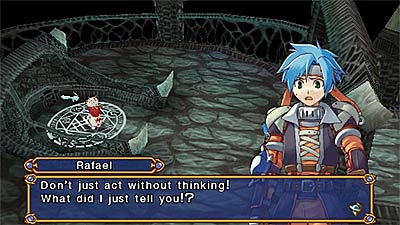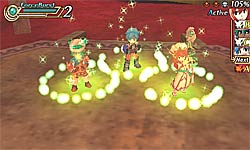Atlus Releases a Double-Edged Sword
Like a cadaver in an expensive tuxedo, Hexyz Force looks nice but makes absolutely no effort to engage or impress anyone. Perhaps the most impressive thing about Hexyz Force is that, after twenty-five years of gaming, I know I can still be fooled into thinking that if a studio makes a game graphically impressive, then it means they’re obviously going to put the same amount of effort into creating interesting gameplay and an engaging story. Hexyz Force is proof positive that sometimes good graphics are just that… and nothing more.

Hexyz Force takes an extremely traditional approach to the RPG format. Combat is turn-based, characters can take front, middle, or back row (with damage received and dealt accordingly), level-ups occur frequently, and combat is commenced on contact with roaming enemies. There are a few tweaks which are overwhelming at first (that is, until you realize that most are completely superfluous). Each character can equip four different weapons, and each weapon can have its own attribute with a rock-paper-scissors system of strengths and vulnerabilities. Elemental attributes are thrown in as well. Each weapon can have a variety of attacks, heals, and buffs, as well as a limited number of uses before the weapon breaks, so battle tactics can change quickly. Each attack has its own sort of “mana” cost, so you can’t continually spam the enemy with your most powerful attacks (not that you’ll need to). Each character also has a main weapon, a Ragnafact, which cannot break during use and can be upgraded in a variety of ways. In addition to all of that, there are special Force Burst attacks that become available as your Force Burst gauge rises during enemy assaults.
Now, all of that makes it seem like the combat system incorporates a steep learning curve, and along with that goes the fear that if you don’t master the system, then there will be some bosses waiting to eat you alive. Strangely enough, Hexyz Force is incredibly easy. Outside of combat, you can heal your team using the same points that are used to upgrade weapons; such a system seems perfect for forcing gamers to learn the ins and outs of the system in order to maximize weapon potential at the cost of not keeping your hit points maxed, but unfortunately, level ups (which heal hit points) are frequent, and most enemies are dispatched with such ease that resource management and healing are never an issue. I kept waiting and waiting for the introductory “training area” of the game to end – but it never did!

It’s strange that the fights are as easy as they are; the challenge level makes Hexyz Force feel like a child’s introduction to J-RPGs, a sort of long tutorial to ease a newcomer into the genre. A newcomer would also get more out of the derivative, unoriginal story than a J-RPG veteran who has already joined rebel group number 718 in the fight against yet another evil empire. But when you think about it, isn’t anyone who is going to play an RPG already into RPGs? Don’t all RPG fans already have several titles under their belt? What newcomer to RPGs is going to randomly pick up Hexyz Force, as opposed to something everyone has heard of, like Final Fantasy? And if all of that is true – and I think that it is – then shouldn’t all combat in RPGs be difficult enough for diehard veterans to wrap their heads around? Or, at the very least, shouldn’t varying levels of difficulty options be standard fare by now?
It’s almost like combat was tweaked for a certain level of difficulty, and then, just before the game shipped, some rogue developers on the team went in and included special attacks and the ability to heal the team both in and out of combat, thus completely throwing off the balance and difficulty level of the entire game. I realize that’s an absurd statement, but it’s equally absurd to be able to steamroll over ninety-nine percent of the game’s enemies, and then to get excited just before a boss fight – only to roll right over the bosses as well. It’s both disappointing and a little confusing. Disappointing because I found myself dozing off more than once during the game, and confusing because I can’t understand what sort of gamer the developers had in mind while making Hexyz Force.

The story doesn’t help sweeten the deal of an otherwise broken game. It deals with the rebirth of magical beings in mortal form, prophecies coming true, an evil empire guided by a mysterious force behind the scenes, and, of course, a rebellion against said empire. It’s pretty easy to put together the pieces of what’s going on – in fact, so long as you’ve played other Japanese RPGs, and don’t hold your eyes tightly shut during character interactions, you’ll figure it out pretty quickly – but the protagonists are continually baffled by the overwhelming mystery of the Hexyz. Levant in particular is guilty of this. A large chunk of his story is devoted to interactions in which he repeats the fantasy equivalent of “Do what now?” every time he is given a hint about his true nature as a Hexyz.

Hexyz Force isn’t all bad. The graphics are very nice, with rich colors and some very memorable character designs. The music is especially evocative; the best parts of the dungeons are always the incredibly immersive atmospheric tracks, which are well worth listening to even when not playing.
Replay value is surprisingly low. When I first started playing, I was very excited by the opportunity to choose between two different protagonists, who each experience the epic struggle from different perspectives. However, the two stories intertwine fairly often, and since the story is already a warmed-over rehashing of stereotypical J-RPG conventions in the first place, playing through Hexyz Force a second time as a new character is like trudging through an unending nightmare that simply can’t end soon enough.
Some of the details change, and the variety of teammates is different, but otherwise, the game’s lack of challenge and perverse need to steer clear of anything that might break from the conventions of the “J-RPG formula” make playing through both of Hexyz Force’s campaigns more of a test of the player’s patience than an enjoyable experience.
RATING OUT OF 5 RATING DESCRIPTION 3.7 Graphics
Great character design and beautiful dungeons do little more than trick prospective players into playing an otherwise dull game. 3.9 Control
Adequate control scheme pays homage to time-tested RPG mechanics without paving any new ground. 4.1 Music / Sound FX / Voice Acting
Occasional voice acting is nice, but the music is incredibly immersive and perfectly conveys the feel of living in a fantasy world. 2.0 Play Value
Don’t be fooled by the option to play as two different characters with different stories, as they match one another so closely that if the first run through of the game didn’t put you to sleep, the second time will. 2.9 Overall Rating – Average
Not an average. See Rating legend above for a final score breakdown.
Game Features:
